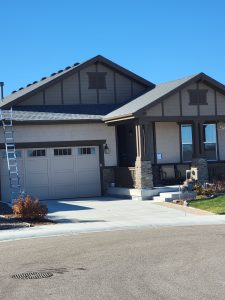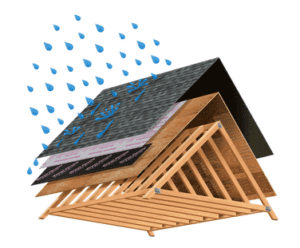In Denver, CO, the efficiency of attic venting is significantly heightened by the incorporation of a well-designed roof ridge venting system. A roof ridge vent is a key component in promoting optimal air circulation within the attic space. Placed along the peak or ridge of the roof, this vent allows warm, stale air to escape from the attic, facilitating a continuous flow of  fresh air.
fresh air.
In this image, you can see the row of roof vents installed on this newer home. Find out the condition of your attic/roof venting system with a free roof inspection. Click here to learn more.
The design of the roof ridge vent is crucial to its effectiveness. Typically, these vents are installed along the entire length of the roof ridge, ensuring comprehensive coverage. They can come in various styles, including continuous ridge vents that run seamlessly along the entire ridge, or individual ridge vent units spaced along the peak. The choice of the specific type depends on the roof’s design and structure.
Roof Venting Design
The mechanics of roof ridge venting are simple yet highly efficient. As the sun heats the roof, the air inside the attic warms up. This warm air naturally rises and exits through the ridge vent, creating a suction effect. Simultaneously, cool air is drawn in through lower vents, such as soffit vents, to replace the expelled warm air. This continuous cycle of air exchange prevents the attic from overheating, reducing the risk of structural damage and promoting energy efficiency.
The benefits of a well-implemented roof ridge venting system extend beyond temperature regulation. It helps mitigate moisture buildup by preventing condensation, which can lead to mold growth and wood rot. Additionally, proper attic ventilation can contribute to the longevity of roofing materials, as excessive heat and moisture are known to accelerate the aging process of shingles and other components.
As a homeowner, it is good to understand that the inclusion of a well-designed roof ridge venting system plays a pivotal role in optimizing attic ventilation in the Denver area. It not only regulates temperature extremes we experience but also addresses issues related to moisture, promoting a healthier and more sustainable roofing environment.
Get a Roof Venting Assessment
Call New Roof Plus or click here to learn more about installing attic venting on your home or building. The call, our advice, and the cost estimate are free!
 also at the bottom of the roof line. The venting system will draw cooler air from below and push the hot air out of the top vents. This air conduction keeps the building temperature steady. This allows for better heating and cooling throughout the year.
also at the bottom of the roof line. The venting system will draw cooler air from below and push the hot air out of the top vents. This air conduction keeps the building temperature steady. This allows for better heating and cooling throughout the year.

 fresh air.
fresh air.